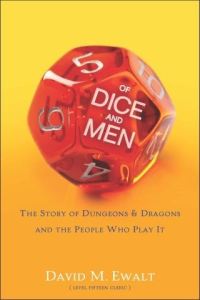Ewalt gives his slender volume the subtitle “The Story of Dungeons & Dragons and the People Who Play It,” at which point my inner copyeditor immediately reaches for the red pencil to change it to “A Story…” and “Some of the People…” There are a lot of stories of Dungeons & Dragons, and Ewalt surely isn’t telling the only one possible. Further, as the second noun in his title indicates, the story he tells is very much dominated by boys and men. The milieu in which D&D arose was almost exclusively male, but by the time it got big plenty of girls and women were playing. Ewalt’s experience of D&D may have been all-male, but mine certainly wasn’t, and it was a bit off-putting to see his blitheness on display.

But as Ewalt says in his introduction, “Read this like you’d play in a friendly campaign. Don’t be a rules lawyer, and don’t argue with the DM.”
He also writes that the book “is largely intended to explain the phenomenon of D&D to a mainstream audience.” Yeah, no. The book is a pleasant trip down nostalgia lane for people who played D&D once upon a time, and who would either enjoy looking back with a bit more added context, or who are happy to expand their understanding of the game and its history without delving too deeply in the depths of the scholarly literature or mining the original sources themselves. Fortunately, that’s a large enough group for a major publisher to take a flyer on both hardback and trade paperback editions.
And in fact, Ewalt has given us several books, or at least several stories. There’s his initial frame: excerpts of his current campaign, with background on the action and the ongoing adventures of his party. This serves as an example of play, and also provides a springboard for reflections on the gaming itself, how it has changed over time, and some more meta themes.
Then there’s the story of his personal involvement with the game, bouncing a bit back and forth between his playing D&D in his formative years and his reconnection with it in a vaguely defined middle age. In this part of the book, Ewalt is working out, or at least appearing to work out, why D&D appeals to him so deeply, and what that means for how he looks at the world.
The third thread is the history of D&D as a game, starting with its ur-ancestor chess but getting more detailed about the development of wargames. The modern hobby traces its origin most directly to training exercises developed by the Prussian army (surprise!), then onto tabletops hosting both miniature figures of soldiers and more abstract cardboard chits by way of a pacifist game developed by H.G. Wells. In Ewalt’s day job, he writes for Forbes, so it’s not surprising that he spins this thread with aplomb, combining interesting facts with vivid vignettes.
The fourth story is that of TSR as a company, from its first shoestring days putting together the very first printing of D&D, through the days of living large in the mid-1980s, unto its quick collapse and absorption by Wizards of the Coast, as trading-card games turned out to be bigger money spinners than D&D. (I suspect that the collapse of distribution for mass market paperbacks played a bigger role than Ewalt lets on (or perhaps knows), because he said that at the time TSR was earning much more from books than games, but one would have to be versed in publishing history arcana to tease this out, and I don’t think that he is.) Here, too, his Forbes background serves him and readers well. If you’ve read much at all about startup companies, you will have seen this narrative: Visionary founders, a product that seems to change the world (or at least some corners of it), rapid success, mismanagement, idealists vs profiteers, the ousting of the founders, retrenchment and eventual absorption by a larger company. To his credit, Ewalt tells this tale as if it’s new, and captures the unique aspects that role-playing games brought to the narrative. He also gives a good sense of the personalities involved, and he’s particularly vivid with the locations where it all took place.
The book is strongest on the first half of D&D’s published life. TSR was sold to Wizards of the Coast in 1997, which in turn was acquired by Hasbro in 1999. There’s not a lot of corporate history from this era that gets mentioned in Ewalt’s book. Maybe it was boring; maybe he just set out to tell an origin story; maybe he ran out of time or space in the planned book. D&D has been in the hands of the Wizards and their minions now for almost as long as it was in the hands of E. Gary Gygax. It might have been interesting to find out more of what they have been up to.
Ewalt also spends some time on the different ways that role-playing has evolved over time. This is of a piece with his explanations of the origins, and his reported personal experiences trying some of D&D’s antecedents, such as Napoleonic miniatures. There’s a good chapter on his visit to a live-action role-playing game (LARP), which is one of the major directions the subculture has gone. He alludes briefly here and there to online and computer gaming, but that subject is so big that he’s basically bracketed it out and decided not to address it. Finally, he gets an advance look at “D&D Next,” what is becoming the fifth edition of the game.
That brings Ewalt full circle, to how the game developed, and what it meant to him. He found styles of play that he preferred, and while he recognized that some people preferred other styles (notably, EGG’s son Ernie), he was at peace with his preferences. He had grown up, and into the game.
